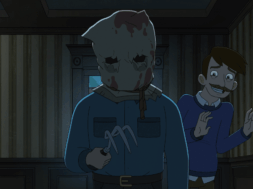Surprising, some people gloss over the fact that the Metroid series has its roots in sci-fi horror. Yes, in spite of the series owing a lot of its influence to the Alien series, most people still see the series as more sci-fi adventure, which is fair (given that this is Nintendo, after all). Yet with Super Metroid, a landmark title that celebrates its 25th anniversary today, horror still has a very real presence with the game, despite its more action-oriented leanings.

It’s no secret that the Metroid series was heavily inspired by the Ridley Scott and James Cameron films. The lone female protagonist forced to battle against a creature that relies on its host to survive. The very Giger-esque creature designs. The cavernous surroundings reminiscent of the derelict alien ship, or the claustrophic colony decks that descend deeper into the planet. It’s all there, and continues in Super Metroid.
From the very start of the game, there’s a very real Aliens feel. The intro recaps the events of the first to Metroid games against a background of Samus looking on at her screen, as her journal entry is typed out. All the while, the fantastically-atmospheric music by Kenji Yamamoto and Minako Hamano gives the intro a very unsettling feel. All at once, the Ceres Space Colony’s distress call abruptly ends the music as the unsettling feeling gives way to tension. The colony where Samus delivered the last Metroid is under attack. That tension ratchets up quickly after Samus flies back to the Ceres Space Colony, only to find it darkened, scientist bodies littering the lab, and an eerie silence. The callback to James Cameron’s classic couldn’t be more obvious.

The callback doesn’t end there, as after discovering the leader of the Space Pirates, Ridley (which yes, is a reference Ridley Scott) is in possession of the baby Metroid. After a brief battle, there’s a self-destruct sequence initiated, forcing Samus to flee the Colony before it explodes. Tailing Ridley, Samus returns to the planet Zebes to begin her hunt to recover the baby Metroid that Ridley has taken. Upon landing on Zebes, the game again uses the inspirations from Aliens to paint the atmosphere: It’s raining, with little to no music, and it’s disturbingly quiet. Really, it’s not unlike when the dropship arrives at LV-426 in Aliens. Samus traverses the eerily-silent corridors and down elevators, the area is devoid of all enemies. Once again, as the marines make their way into the complex searching for the missing colonists, there’s an eerie silence. The complex gives way to the hive, which is where the real nightmare begins.
Once Samus arrives and acquires her trademark morph ball, a security camera(?) activates and tracks her. In the next room following that, Samus comes face to face with the Space Pirates, which have now swarmed the area. It’s not unlike the discovery of the missing colonists by the marines, the disturbing of the hive, and all hell breaking loose. This mirroring of Aliens typifies the type of sci-fi action/horror Sakamoto was going for with Super Metroid.
Later on, Samus comes across a crashed alien space craft that’s been left to rot for over what appears to be an extraordinary amount of time (a nod to the derelict craft in Alien, perhaps?). Inside, the ship is haunted by the spectres of the original crew that disappear and reappear. Eventually, you make your way further into the ship, where Samus encounters the spectral Phantoon, which at first glance might not seem to ape one of Giger’s creations. However, Alien buffs will recall the Luigi Cozzi-directed Contamination, which is a blatant Alien rip-off. Phantoon looks suspiciously similar to the alien in Contamination. Or perhaps, given Phantoon’s supernatural and multidimensional traits (not to mention his overall appearance), could it be a reference to a creature out of H.P. Lovecraft’s Cthulhu mythos?

Another boss battle, the battle with Kraid, can be seen as another reference to Aliens. During the search for and rescuing of Newt, fighting off the Xenomorphs as she makes her way through the bowels of the complex, Ripley finds herself faced with the massive Queen Xenomorph, which towers over Ripley as it awakens and raises itself up. Similar to that is Samus’ approach to Kraid, where she fends off against Kraid’s spawn before coming to Kraid itself, which towers over Samus, requiring her to scale the beast to attack it.
All the references to the Alien franchise aside, Super Metroid does have more horror aspects than just tributes. Despite what you might expect from a first-party Nintendo game, Super Metroid does feature some bloody bits. Super Metroid was released shortly after the formation of the ESRB, the regulatory body that determines the age ratings for video games. There was concern that some of the more violent aspects of the game would cause a backlash for Super Metroid, which thankfully didn’t happen.
Still, the battle with the first Chozo Statue that unexpectedly comes to life after Samus takes the Bomb item is an intense and gory one (as far as a 16-bit Super Nintendo game goes). As Samus damages the now-living statue, its chest bursts open, with “blood” dripping out of the gaping hole. Eventually, Samus shoots off the statue’s head, but instead of dropping to the ground, the statue intensifies its attacks, flailing its arms around and running across the room.

Then there’s the battle with Crocomire, where Samus forces the creature backwards until it backs onto a platform that crumbles into the Norfair lava. Despite what you’d expect, Crocomire struggles in vain to climb back onto the platform, its flesh melting from the heat. Once it finally sinks down into the lava, you’d think you’re safe. Not so, as when Samus turns back to escape the room, the spiked wall gives way to the skeletonized remains of Crocomire, in a last gasp attempt to get Samus.
Finally, in the climactic battle with (sorry, spoiler alert!) Mother Brain, Samus once again forces her way into Mother Brain’s lair to take on the head of the Space Pirates. In a repeat of the first game, Samus destroys Mother Brain’s “jar” and apparently kills Mother Brain, only for her to reveal her true form: A one-eyed bipedal monster with drooling saliva and noxious breath. According to designer Toru Osawa, he modelled Mother Brain to look like an “old lady living in my apartment complex”. Upon defeating Mother Brain (with the help of the baby Metroid), Mother Brain’s head falls to the ground, withers and crumbles to dust. From there, it’s yet another callback to Aliens, mirroring the beginning of the game, where Samus must escape Zebes before it blows up.

But with all of that, even if you choose to believe Super Metroid was more action sci-fi, and you ignore the horror aspects, as horror fans, why celebrate the game? Well, three years after Super Metroid, Konami released a little game in their Castlevania series that adopted many of the mechanics found in the Metroid series in Symphony of The Night, which is widely regarded as one of the best Castlevania games ever. Sure, the perceived horror is different, but had the Metroid series not been as successful, or had successfully demonstrated even a little horror in its gameplay, would we have gotten SOTN?









